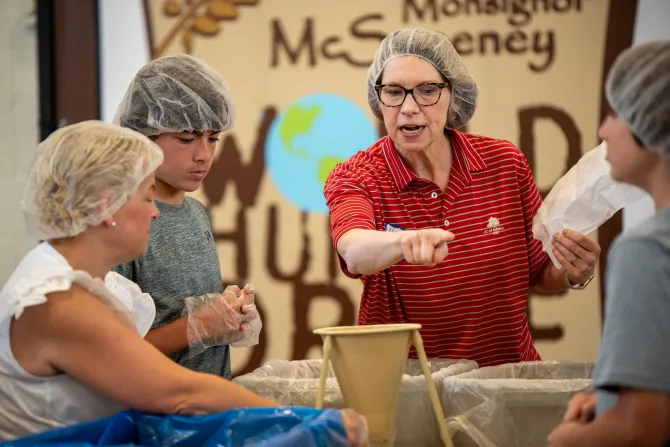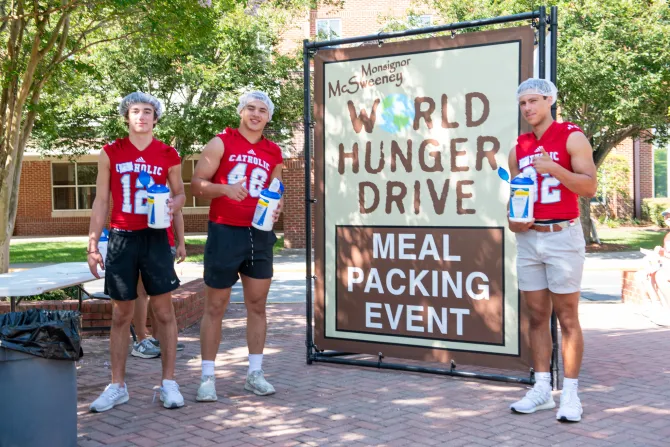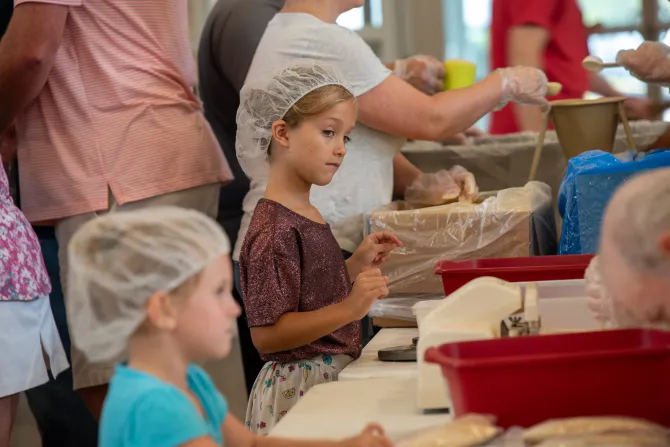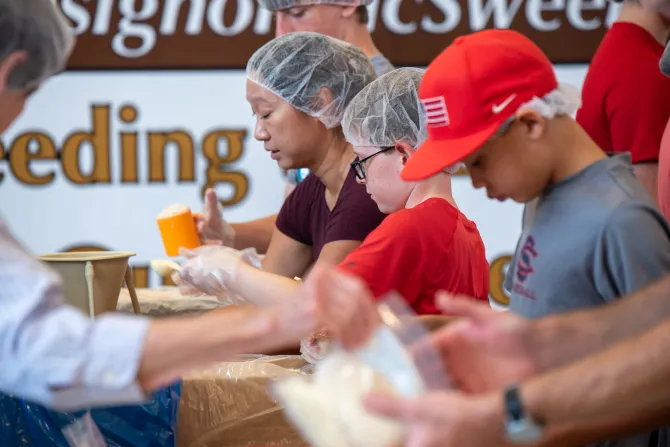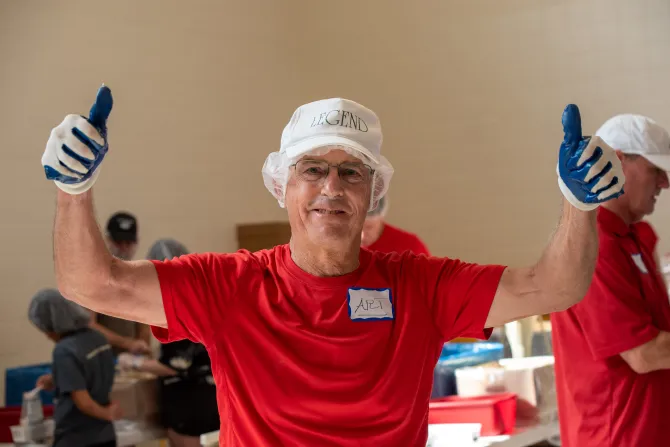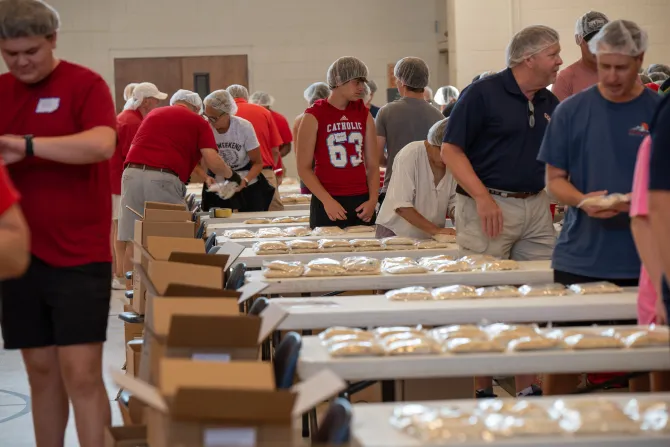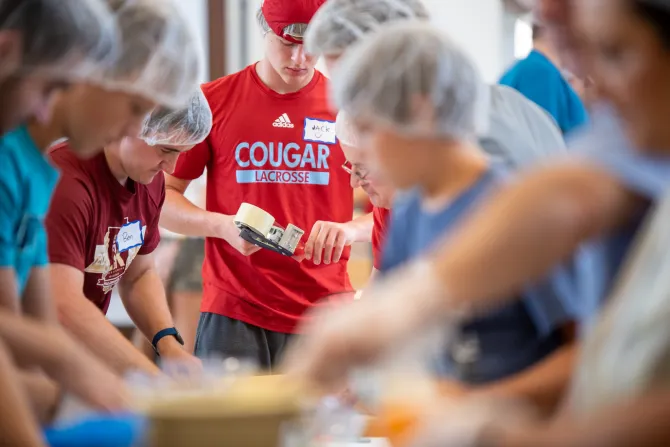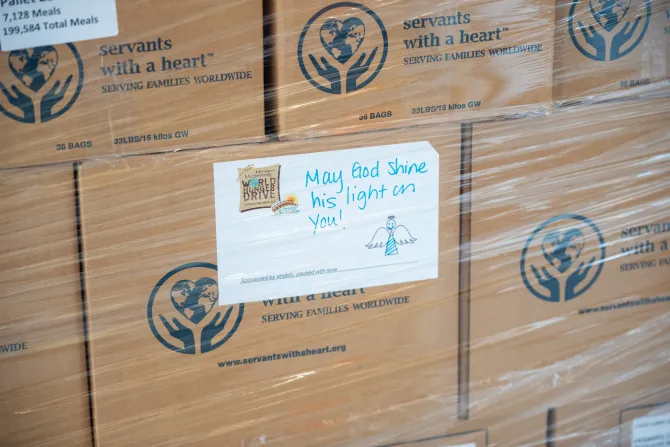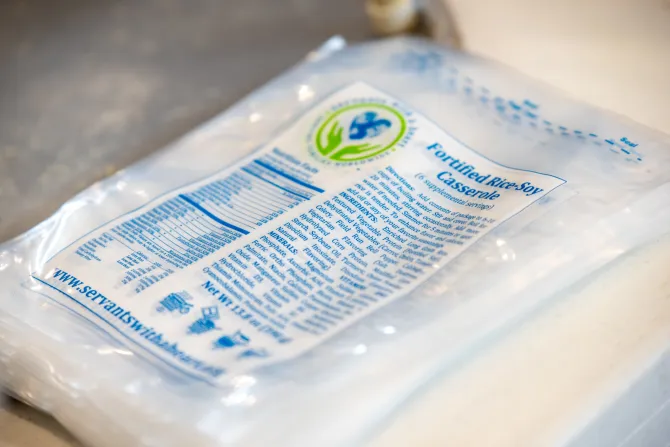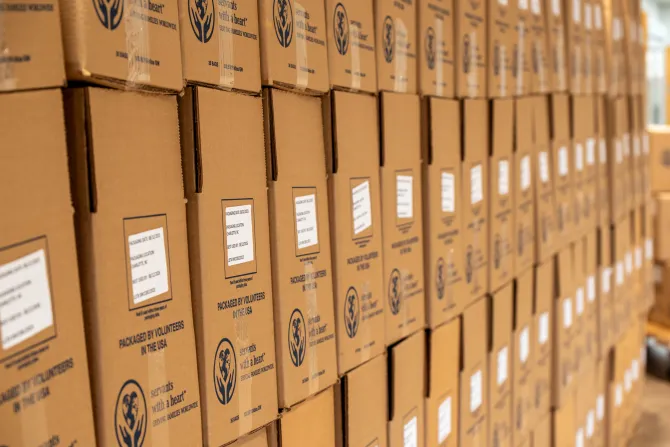Charlotte, North Carolina, Aug 20, 2023 / 07:00 am
OK, pay attention. There are three important things to remember — are you listening? — when you volunteer for St. Matthew Catholic Church’s massive annual meal-packing event here in Charlotte.
They are: The rice goes in last; keep your hair net on at all times; and the rice goes in last.
Got it? Good. Because this isn’t like selling brownies after the 5 p.m. vigil Mass. This is the big leagues of parish-based brotherly love. There are instructional videos, forklift operators, logistics experts, and three work shifts totaling more than a thousand participants organized into eight-person assembly lines.
Everybody’s got a job. Everybody wears a hair net. And at the end of the day, when the dehydrated vegetable dust settles and the well-oiled machine that is the Monsignor McSweeney World Hunger Drive comes to a halt, as it did again for the 21st time on Aug. 12, the output is prodigious: truckloads of cardboard boxes containing the equivalent of more than 300,000 nutritious, ready-to-cook meals, most of which are bound for Haiti.
That’s a lot to process, in more ways than one. What you need to understand is that St. Matthew is just like your parish, only 10 times larger.
Located in Charlotte’s upscale Ballantyne neighborhood, St. Matthew is a bonafide megachurch, with some 11,000 families on the parish rolls, 101 busy ministries, and a cavernous, 2,100-seat modern sanctuary with jumbo video screens flanking the altar.
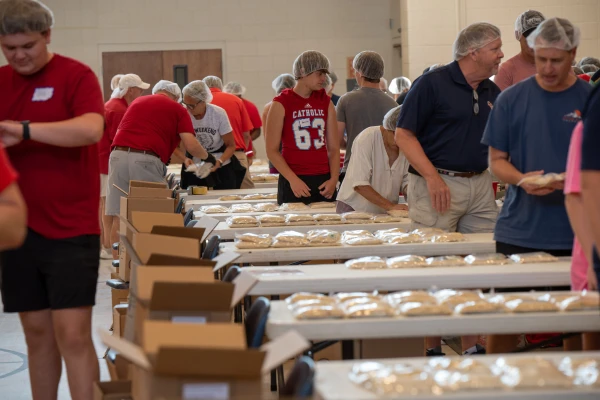
Everything about St. Matthew is super-sized, including its charitable outreach. And that’s a good thing, because no country in the Western Hemisphere needs a big-hearted Catholic community like St. Matthew in its corner more than Haiti does now.
Remember the earthquake that devastated the Caribbean country in 2010? The living conditions there are far worse now.
Haiti is in a slow death spiral. When President Jovenel Moïse was assassinated in July 2021, chaos ensued. Two years later, there’s still no presidential successor, the national government has effectively ceased to function, the power grid is down, and armed gangs rule the streets of the capital, Port-au-Prince.
What makes the situation worse than it was after the earthquake is that humanitarian groups can’t rush to the rescue. It’s simply too dangerous. In July, the U.S. embassy in Port-au-Prince ordered its nonessential personnel to return to the United States. The State Department has issued a Level 4 advisory cautioning Americans not to travel there.
“Violent crime, often involving the use of firearms, such as armed robbery, carjackings, and kidnappings for ransom that include U.S. citizens are common,” the embassy warns on its website.
“Travelers are sometimes followed and violently attacked and robbed shortly after leaving the Port-au-Prince international airport," the advisory continues. "Robbers and carjackers also attack private vehicles stuck in heavy traffic congestion and often target lone drivers, particularly women.” An American nurse for a Christian aid group was freed earlier this month with her daughter two weeks after they were abducted from a school near the capital. She said the Christian song “See a Victory” rallied her spirits during their captivity.
“Right now there is nothing functioning in the country,” Brother Louima Israel, the local superior of the Missionaries of the Poor in Cap-Haitien on the north coast of Haiti, where the order operates aid centers for children and the elderly, told CNA. “Even if you have money, there’s nothing to buy. And politically there’s nobody in charge.”
A call to action
What can one Catholic parish do? A lot, it turns out.
(Story continues below)
The parish has had a close relationship with the Missionaries of the Poor and its founder, Father Richard Ho Lung, since the late 1990s. When the first group of parishioners visited the order’s base in Cap-Haitien years ago they asked how they could help. “We need food,” was the response. So St. Matthew got busy.
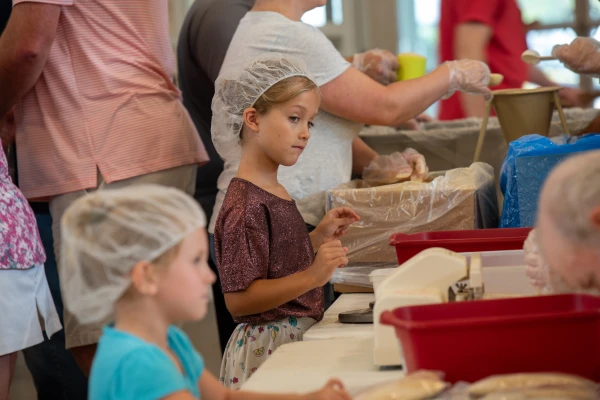
To date, its annual food drives have yielded more than 4.1 million pounds of food and medical supplies, including 3.4 million meals — the fruits of more than 48,000 volunteer service hours. Most of the aid goes to Haiti, but the parish also helps the poor in India, Jamaica, Venezuela, and close to home in the greater Charlotte area.
The parish also has raised hundreds of thousands of dollars for educational and sustainability projects in northern Haiti, including a sewing trade school, an agricultural training center, and a K-12 school, St. Marc’s, which recently graduated its first college-bound student.
“Our parishioners truly feel the people we are helping are part of our family and understand how critical the needs are,” said Steven Favory, executive director of a nonprofit called Hands for Haiti founded by St. Matthew parishioners that coordinates charitable projects in Haiti year-round.
The most visible of these efforts is the annual meal-packing event, which has become so popular that volunteer spots get snatched up like Taylor Swift tickets when registration opens a few weeks beforehand.
An annual fund drive, named for a former pastor who got the effort underway, pays for the raw ingredients: soy protein, dried vegetables, vitamins, and rice. These components get scooped into plastic bags — in that order. Then the bags get weighed, sealed, and packed in boxes.
About the rice: It goes in last. That's because each bag must weigh between 390 and 400 grams. Any more or less and custom inspectors may get suspicious, so the workers manning the scales add or subtract grains of rice until they hit the mark.
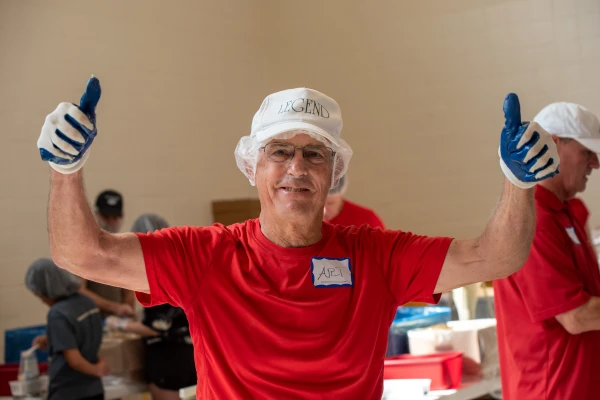
Sounds stressful? It’s really not. There are muscled football players from Charlotte Catholic High School on hand to do the heavy lifting, lots of friendly supervisors bouncing from table to table to offer pointers and encouragement, and a DJ blasting classic rock to keep the mood light and the assembly lines humming.
When the next milestone is reached (“Fifty-thousand meals!”) someone rings a bell and everyone cheers.
“The meal-packing event is almost like a competition because we try to pack as many as we can most efficiently as we can,” explained Ed Billick, a retired operations executive for Frito-Lay who joins the effort every year with a group of his friends.
“We challenge each other at the table and we bust each others’ chops a little bit and kid around and motivate each other and just have a good time,” he said. “So, yeah, it’s about feeding the poor in Haiti, but gosh, it’s [also] about getting together with your brothers and sisters in Christ and just having some fun.”
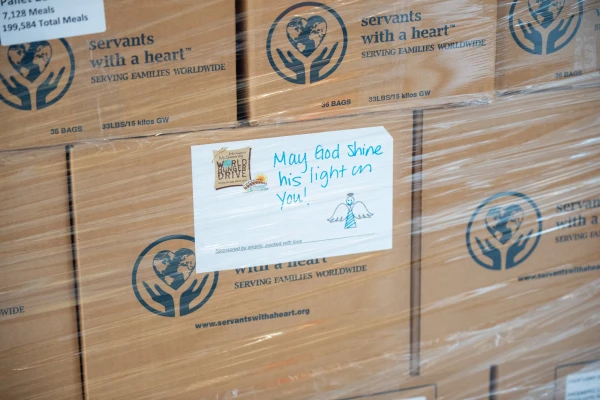
Some people might wonder if it’s really worth it. Isn’t 300,000 meals a year, as impressive as that sounds, just a drop in the bucket for a country with the enormous needs that Haiti has?
Those kinds of questions stop when you have an opportunity to see a student at St. Marc’s School sitting down to eat one of those meals. In some cases, Favory says, it’s the only one they’ll eat all day.
The point isn’t to fix Haiti, he says, it's to make a difference where you can. Each person does their small part, trusting that God can fill the gaps with his grace, just like the extra grains of rice, which go in last, fill up all those life-saving meals.
To donate to the St. Matthew food drive, click here.


